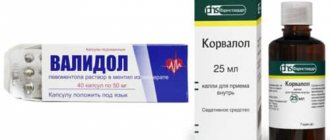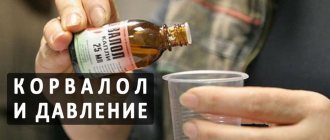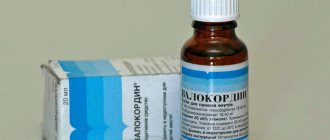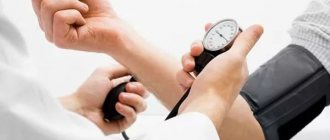Home>Articles> How dangerous is it to take Corvalol and Valocordin with alcohol?
quick menu (hide)
- Compatibility of Valocordin and alcohol
- In what cases can you combine drugs with alcohol?
- What can you buy at the pharmacy for a hangover?
- Traditional medicine for hangovers
Preparations containing phenobarbital are incompatible with alcohol. This rule applies to Corvalol, Valocordin, Valoserdin. You can drink such heart remedies some time before drinking alcohol, or after drinking libations, having agreed upon this possibility with your doctor.
Corvalol drops: composition
The drug contains mint oil, ethyl bromizovalerianate and phenobarbital.
Peppermint is known for its ability to have a calming effect on the nervous system. In addition, mint helps blood vessels dilate.
Phenobarbital is a special component that enhances the effect of other substances that make up Corvalol. In particular, it contributes to the rapid manifestation of a sedative effect on the central nervous system and the body as a whole. Thanks to phenobarbital, Corvalol makes it easier for a person to go to sleep, which is especially important after suffering stress.
Ethyl bromizovalerate is responsible for the antispasmodic effect accompanied by a strong sedative effect.
Drops contain alcohol as an auxiliary component.
Characteristics of drugs
Corvalol or Valocordin is a group of drugs that have a sedative and antispasmodic effect, thanks to the active substance - phenobarbital.
Medicines are available in tablet form and in the form of drops
Initially, Valocordin was produced in Germany using a specially developed formula. After some time, its formula was introduced in the CIS countries, as a result of which its analogue appeared - Corvalol. Currently, the drugs are banned in Europe due to their toxic effects on the brain and liver. However, they continue to be in demand among the elderly population in the countries of the former USSR due to their low cost and sale without a prescription.
The therapeutic effect of both drugs is aimed at eliminating vascular spasm, as a result of which normal blood circulation is restored. The duration of the therapeutic effect of such drugs is determined by the concentration and rate of elimination of the active substances from the body. So, if the medicine is removed, negative symptoms may resume, but in the presence of concomitant diseases.
How many drops of Corvalol to take?
Most often you can find Corvalol in drops. It is sold in glass vials equipped with a dropper. Therefore, the question most often arises of how many drops you need to drink in each specific case. There is an opinion that it is correct to take into account the following calculation: 1 drop per 1 year of life. However, medicine says that this is wrong.
A single dose should not exceed 30 drops. Corvalol concentrate must be dissolved in a sufficient amount of water. The more liquid you take for dilution, the less pronounced the taste of the medicinal solution will be. In special cases, the single dose can be increased to 50 drops.
You can repeat the reception up to three times a day. It is important that the daily dose does not exceed 100 drops.
It is not recommended to take Corvalol as a course without consulting a doctor. Unlike long-term use, a one-time use during stress does not pose a danger to humans, however, constant use of the drug can also have a negative effect on the body.
What is the difference between the drugs?
There is no particular difference between the drugs, since they both contain barbituric acid, which has antispasmodic and sedative effects. Medicines are used to treat neurogenic diseases, as well as to eliminate the symptoms of disorders in the cardiovascular system.
Before starting barbiturate therapy, it is necessary to consult with a specialist so that he can select the optimal treatment regimen and help take into account all contraindications
However, there are some differences between the drugs:
- The presence of essential oils of hop cones and mint in Valocordin.
- The cost of Corvalol is lower than its foreign counterpart.
- The release form of the domestic drug also includes tablets.
Overdose
Due to the fact that the drug contains bromine compounds, an overdose can provoke:
- depression;
- rhinitis;
- inflammation of the conjunctiva;
- lack of coordination;
- drug dependence.
With prolonged use, patients note the appearance of dizziness, increased drowsiness, and the appearance of allergic reactions.
With liver failure, a rash may appear, accompanied by severe itching. Each meal will make the rash worse, even if Corvalol is stopped. Patients with phenobarbital poisoning note the appearance of edema, which indicates an exacerbation of renal failure. If such a reaction occurs, the patient should urgently call a doctor and, if necessary, be hospitalized.
Valocordin, validol, corvalol, Zelenin drops
Surprisingly, heart medicines originally from the early 20th century are still found on pharmacy shelves. They are not only witnesses to the popularity of pyramidon, in the past they had to coexist with cocaine and morphine. But this is not the main thing; what is much more important is that, in general, “old people” do not work, being drugs of reflex action. They also contain harmful substances and help prolong heart problems.
Behind
These drugs are time-tested. Our mothers and grandmothers drank and continue to drink them; many without “fifteen drops” of Valocordin or Corvalol (and also validol under the tongue) will not be able to calm down a restless heart, what else can they do to relieve heart pain.
Cons This is the main problem with these drugs. After all, among their components there are only soothing ones. And heart problems are associated with vascular atherosclerosis and impaired blood flow to the myocardium. “Drops and lollipops” are not able to adequately dilate the heart vessels and reduce the load on the heart (as nitrates do), and people often waste time relying on their effectiveness. As a result, a stable attack of angina becomes unstable, and a heart attack may occur.
Every time you don’t want to take serious medications, “magic drops” help not only relieve discomfort in the heart area, but also help you calm down and fall asleep. Cons Modern doctors recognize that Corvalol and its brothers are effective only in the case of cardioneurosis and general agitation, helping to relieve both. But this is where their danger lies. The fact is that the drugs (in particular Valocordin, Corvalol) contain the sleeping pill phenobarbital, which has been banned for use in the European Union for many years. Because the drug is from the first generation of sedatives, which is called “hard”. And those who use these drugs every day (and this often happens) can harm their health.
Pros The drugs are easy to use and cheap. This is a real lifesaver for retirees. Our fellow citizens are accustomed to them, and leaving the market will be negatively perceived by society.
Cons As one doctor said, banning Valocordin is the same as introducing prohibition. Alas, society’s habit of “drops” and “lozenges” is largely due to the fact that these drugs often cause drug addiction. Due to the content of the same phenobarbital, valerian, ethyl alcohol and other components that calm the nerves, and thereby accustom us to ourselves. According to the observations of psychiatrists, stopping these medications after long-term regular use causes all the symptoms of “minor withdrawal” - irritability, aggression, a sharp deterioration in well-being, headaches and tremors.
Conclusions "Health".
We are not calling for a ban on “heart lollipops and drops.” Although some of them, containing outdated components banned in many countries, are questionable, to put it mildly. Another thing is important - they should finally begin to be used exclusively for indications. Perhaps they will have to be made prescription, or perhaps a certain monthly sales rate per patient may be introduced. The situation when many people waste time and do not receive adequate treatment for coronary heart disease is too costly for society. As is the widespread phenobarbital addiction among pensioners.
The old guard
Validol
Validol was first produced in Germany in 1897. The instructions say that this is a “Drug with a reflex vasodilator effect,” and according to the chemical structure it is menthol in the menthyl ester of isovaleric acid. There have been no clinical studies of the effectiveness of validol in coronary heart disease, and the indications for use are vague.
Valocordin This well-deserved drug consists of a whole chemical cocktail, the basis of which is bromovaleric acid, the sleeping pill phenobarbital (by the way, prohibited for use in the European Union) and ethyl alcohol. The instructions say that the medicine can help with mildly expressed spasms of the coronary vessels (I wonder who measured their severity?), but in fact it is a sedative with a slight hypnotic effect.
Corvalol
A brother of Valocordin, which inherited not only its chemical structure, but also its popularity. Unlike his older brother, he is not known outside the republics of the former USSR.
Zelenin drops
This miracle medicine contains tincture of lily of the valley, belladonna, valerian and menthol. Previously, it was positioned as a remedy for cardiac neurosis (now we will say cardialgia), and, like previous medications, it can be used under one important condition - if the ischemic nature of heart pain is excluded in advance.
Author: Alexey Fedorov Published: March 20, 2019
Special reactions to the components of the drug
The following negative reactions were observed in patients taking Corvalol:
- nausea;
- vomit;
- constipation;
- feeling of heaviness in the stomach;
- increased weakness;
- dizziness;
- hallucinations;
- headaches in the frontal lobe;
- anemia;
- thrombocytopenia;
- difficulty breathing.
What is the difference between Validol and Valocordin?
The history of Valocordin begins in the middle of the twentieth century, when the German drug Corvalol appeared, the chemical composition of which was adapted for production in the USSR.
This is probably the main difference between Corvalol and Valocordin. By the way, it is no longer prescribed in Europe, and it is produced “exclusively” for the countries of the post-Soviet space. The action of Corvalol has something in common with the action of some components of Valocordin, but Valocordin is a complex medicine, and Corvalol is a single drug (with one active ingredient).
Is it possible to use Corvalol for VSD?
Vegetative-vascular dystonia is not a diagnosis, but this condition well characterizes the well-being of many people. It is accompanied by fatigue, dizziness that occurs with a sudden change in body position, including darkening of the eyes. Dystonia is a condition of blood vessels in which they do not have time to respond to a change from a horizontal to a vertical body position, and also cannot expand in a timely manner to allow more blood to pass through during sports activities.
In this case, the effect of Corvalol is explained by several factors:
- mint makes blood vessels more elastic;
- bromine reduces anxiety, which increases the symptoms of VSD;
- phenobarbital enhances the effect of the other two components, improving sleep.
Indications for use
Valocordin or Corvalol is widely used to treat diseases of the nervous and cardiovascular systems.
Taking medications helps patients delay an angina attack for a short time
Valocordin helps eliminate the following symptoms:
- relief of a pain attack in the left side of the chest;
- disturbance of rhythmic contraction of the myocardium;
- insomnia;
- causeless attacks of fear;
- neurotic disorders.
The drug reduces tension in the nervous system and eliminates vascular spasms.
The action of Corvalol is aimed at eliminating the following symptoms:
- Increased excitability of the nervous system.
- Narrowing of the coronary vessels.
- Decrease in blood pressure readings.
- Functional disorders in the cardiovascular system.
- Spasm of the walls of the digestive tract.
Corvalol, Valocordin or Valoserdin are a group of drugs whose action is aimed at lowering blood pressure, so the opinion that these drugs increase blood pressure is erroneous. As a result, patients experience drowsiness and a feeling of peace after a decrease in blood pressure. Such medications should be taken with caution by patients diagnosed with hypertension, as well as by persons prone to lower blood pressure disorders.
How to take Corvalol for herpes
The effectiveness of Corvalol against the herpes virus, which manifests itself on the lips in the form of ulcers, has been noted. It is important to use Corvalol at the first sign of a painful sore on the lips. In order to prevent the disease from developing, it is necessary to wet a piece of cotton wool or one end of a cotton swab with Corvalol and apply it to the ulcer. A tingling sensation will indicate that the drug has begun to destroy the ulcer. Alcohol, having a drying effect, will speed up recovery. You need to repeat the procedure several times a day until the tingling stops.
Corvalol and alcohol - compatibility
Corvalol is created on the basis of phenobarbital. This substance belongs to the group of psychotropics, which requires extremely careful use of the drug.
Combining Corvalol and alcohol can provoke:
- Severe delirium (mental disorder).
- Impaired brain function.
- Pain in various parts of the body.
- Withdrawal syndrome, reminiscent of withdrawal in drug addicts.
- Comatose states.
The instructions included with Corvalol contain information regarding its incompatibility with alcoholic beverages . Ethanol can greatly enhance the toxic properties of this drug, as well as unwanted side effects. If shortly before or after taking Corvalol a person drinks even a small amount of alcohol, this can cause the development of negative consequences (pronounced “inhibition” and others).
General information about Valocordin and Valoserdin
Valocordin is a combined medication with hypnotic and antispasmodic effects. The scope of application of the drug is neurological, cardiac and vascular disorders. Its sedative effect affects the centers of the nervous system - relaxes nerve fibers, relieves muscle tension, which helps restore balance in the psycho-emotional state.
The vasodilating effect helps reduce compression behind the chest and, by improving blood flow, reduces blood pressure and the load on the myocardium.
The main components in the drug are:
- What is the difference between the drug Corvalol and Valerian and can you take them together?
- phenobarbitals;
- ethanol;
- ethyl bromoisovalerate;
- hop;
- mint oil.
Valoserdin is a drug that has a similar effect on nerve fibers as Valocordin. Drops reduce tension in nerve fibers at the time of overexcitation and increase blood flow in the myocardium. From the first minutes after taking the drops, the patient feels relaxation of nerve and muscle fibers, shortness of breath goes away, heart rate decreases, and psycho-emotional balance is restored.
Description of the drug
Valoserdin is not specifically prescribed for the treatment of hypertension and cardiac pathologies, but as first aid for a sharp rise in pressure and discomfort in the heart area, many hypertensive patients take drops, which helps relieve an attack.
Side effects and overdose
In many Western countries, taking Valocordin is prohibited due to the presence of phenobarbital, which is a narcotic drug. Both medications often cause drug dependence, both physical and psychological.
To relieve attacks of neurotic overstrain, new medications have been developed without the use of phenobarbital, which are safe for the body, but their cost is much higher than Valocordin. If you use medications Valoserdin or Valocordin for a long period of time, the development of quite severe negative reactions of the body is possible:
| System | Negative reactions |
| Centers of the nervous system |
|
| Respiratory system |
|
| Blood circulation system and heart |
|
| Digestive tract |
|
| Hematopoietic system |
|
| Allergic reactions |
|
An overdose of a medication is manifested by the following symptoms:
- dizziness;
- deep and long sleep;
- body fatigue.
In case of severe drug intoxication, the following signs appear:
- rapid heartbeat that slows down;
- breathing is frequent and shallow, then slows down;
- severely reduced blood pressure;
- lack of reflexes;
- a coma state in which organ hypoxia begins to develop;
- pulmonary edema.
To treat intoxication, the patient is urgently taken by ambulance to the intensive care unit, where doctors will ensure the supply of oxygen to the organs using an artificial respiration apparatus.
It is also necessary to restore blood flow with the help of an infusion of blood plasma, or with the help of medications that increase the volume of plasma blood. If an overdose occurs accidentally, then you must immediately rinse the stomach (induce vomiting) and drink sorbents. And be sure to go to the hospital for further treatment of symptoms of barbiturate overdose.
Contraindications and complications in case of overdose
It is necessary to take into account the possible harm of drugs when taken uncontrolled. There is a danger of overdose, accompanied by a sharp drop in blood pressure and collapse, disruption of the central nervous system due to the action of cardiac drugs. In addition, many patients may experience severe depression, weakness, and lack of coordination.
Contraindications to taking these drugs are pregnancy, hypersensitivity to the components that make up them, impaired kidney and liver function, as well as injuries and diseases of the central nervous system. In addition, Corvalol and Valocordin are not recommended for use in cases of pronounced hypotension and in patients under 18 years of age.
And also Valocordin and Corvalol should not be taken by patients who, due to their activities, must be attentive, for example, drivers. This is caused by the presence of alcohol and phenobarbital in the drugs, which have a depressing effect on the central nervous system.
Give me medicine for arrhythmia!
The concept of “arivitamin for the heart.” This is complete nonsense; such “vitamins” do not exist in nature. The heart is not a strawberry patch, and medicine is not manure. So in most cases it is a waste of money.
Beta blockers (anaprilin, obzidan, atenolol, concor). These drugs slow down the pulse and can actually be effective for certain types of arrhythmia (tachycardia, extrasystole). But they can also be ineffective, and they can also be harmful.
In order for a doctor to prescribe such drugs, he needs to carefully analyze at least a cardiogram. Blindly, without monitoring the heart rate, without knowing the mechanism of arrhythmia, these drugs can be dangerous, especially in older people.
What should you pay attention to when choosing between these drugs?
First of all, you need to pay attention to the need to take the drug with phenobarbital in general. If you expect only a sedative effect from the drug, it is better to replace it with something safer, for example, motherwort tincture.
The difference between Corvalol and Valocordin is obvious: these are two drugs with different complex compositions that must be taken if indicated. But in any case, they cannot act as first-line drugs for the treatment of cardiovascular diseases, and their use as symptomatic therapy sometimes also raises questions about the appropriateness, since in 2007 these drugs were declared obsolete, with unproven effectiveness, although In 2009, Validol regained its title as a medicinal product.
Aspirin for blood thinning
The idea of taking aspirin just like that, for prevention, “to thin the blood,” because “all friends over 45 already take it,” was very popular just recently. It was believed that aspirin's ability to prevent platelet aggregation could significantly reduce the risk of myocardial infarction and other vascular accidents.
However, it turned out that if a healthy or almost healthy person takes aspirin, the number of heart attacks prevented is very small, but the risk of bleeding increases. Therefore, cardiologists around the world are gradually reconsidering the idea of the preventive role of aspirin in healthy people, prescribing it only to patients with coronary heart disease (including after myocardial infarction and bypass surgery/stenting), patients after a stroke, as well as with severe atherosclerosis of the blood vessels of the legs.
In other words, you should not take aspirin on your own, without a doctor’s recommendation.
It is bad when the patient does not have one attending physician who would completely control the therapy. In this case, the patient independently goes from doctor to doctor, collecting prescriptions for the treatment of various diseases. For some reason, every doctor considers it his duty to prescribe at least four or five drugs, which seems to be frivolous otherwise. If the patient decides to take all of this, 15–20 items will appear in his medicine cabinet at the same time. Sometimes patients come to me with a specific task: “Doctor, the clinic prescribed me a total of 20 medications. Help me reduce their number..."
Advertising
First aid for a heart attack (heart attack).
A heart attack (infarction) is the death of a section of the heart muscle (myocardium) , caused by blockage of a vessel supplying this section of muscle with blood.
Without blood supply, the heart muscle begins to die and, if help is not provided in time, it dies irrevocably.
The risk of deterioration and death is very high - about 35% , you can’t delay! The life of the victim depends on your quick and clear actions.
Main features:
- Pressing pain in the center of the chest. A person can hold on to the “heart,” unwittingly showing where the problem is. The pain often radiates to the left arm, left shoulder blade, and neck on the left side.
- Dyspnea at rest - difficult, frequent, shallow breathing , as after physical activity. May not go away even after rest.
- Pale skin and cold clammy sweat.
IMPORTANT!
- When diagnosing, focus primarily on 3 main signs! The victim may have other symptoms: dizziness, weakness, nausea, etc. But they occur in many diseases and blur the picture more than they help in diagnosis.
- Call an ambulance even if you have one of the main signs. Don't wait for all 3 to appear. They may never appear all together.
Your actions:
- Call an ambulance - 103 or 112 from any phone - and clearly, in simple language, describe all the manifestations. For example: a 45-year-old man, sitting, holding his chest with his hand, pale, having difficulty breathing. If the patient refuses to call an ambulance, but looks bad, call him anyway! By law, you do not need the victim’s consent to call an ambulance.
- Aspirin 325 mg. A simple Aspirin given at the first sign of a heart attack reduces mortality by 15%!!! Aspirin prevents the growth of a blood clot that has blocked a vessel in the heart muscle and preserves the possibility of at least some blood supply.
IMPORTANT!
- The Aspirin tablet should be chewed and not swallowed whole. Instruct the victim.
- under any circumstances exceed the dose of 325 mg!!! This can sometimes have the opposite effect and make the condition worse. Look carefully at the dosage indicated on the package.
- Do not give Aspirin if the person is allergic to this drug.
You don't need to do anything else. Observe the condition of the victim, support him morally, wait for the ambulance.
Not to do!!!
- Nitroglycerin - do not give! It can greatly reduce blood pressure and even kill the victim before the ambulance arrives. If the patient wants to take it, you can help him take his own Nitroglycerin. In this case, it is his decision and his risk. You are not responsible for the result. If you “prescribe” him your drug yourself, then in the event of a tragic outcome, you risk being charged. Prescribing prescription medications is not your responsibility and is not part of First Aid.
- There is no need to give Validol, Valocordin, Corvalol. Validol is a placebo and has no real effect on the heart at all. Valocordin and Corvalol are sedative drops that do not have a strong effect on blood circulation in the heart muscle, but they cause a drowsy state, which makes it difficult for doctors to diagnose. Especially in case of an overdose, which is carried out by “rescuers” out of “generosity” and fear.
Any knowledge is useless if it does not lead to action.
And here’s what you need to do right now so that knowledge does not remain just knowledge:
- Tell everyone in your family what you learn about the heart attack. Just tell it in your own words. Firstly, by passing on information to others, you yourself will remember it even better. Secondly, you create a safe environment around yourself that can help you if you suddenly become a victim.
- If you have children, make sure they know how to call 911. They may be the only ones near the victim, and the salvation of parents and grandparents will depend on their timely call for an ambulance.
- Make sure you have Aspirin in your home medicine cabinet . Look carefully at the dosage to understand how many small tablets to give or how many pieces to break a large tablet into. For simplicity, buy Aspirin in a dosage of 325 mg.
- If you don’t have Aspirin at home , be sure to buy it at the pharmacy . Immediately take Aspirin at a dosage of 325 mg. It can be used not only for a heart attack, but also for any situation such as headache, fever, hangover, etc.
- If you have family members with heart disease , make sure you know exactly what medications they are taking and why. What allergies do they have? This is important to know in case their condition worsens and they are unable to instruct you about treatment. Prepare in advance!
- If you yourself suffer from heart disease , be sure that your immediate family, including your children, know what pills you are taking and what they should do if you suddenly feel unwell.
Be prepared and may you never need it!
Author: Artyom Kharchikov
PS Was the material useful to you? Please leave a review 
It is very important for us to know your opinion about our work!









